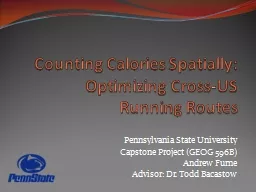

Running Routes Pennsylvania State University Capstone Project GEOG 596B Andrew Furne Advisor Dr Todd Bacastow Table of Contents Background Explorers to Runners Destination Connect the Fleets ID: 669700
Download Presentation The PPT/PDF document "Counting Calories Spatially: Optimizing ..." is the property of its rightful owner. Permission is granted to download and print the materials on this web site for personal, non-commercial use only, and to display it on your personal computer provided you do not modify the materials and that you retain all copyright notices contained in the materials. By downloading content from our website, you accept the terms of this agreement.
Slide1
Counting Calories Spatially: Optimizing Cross-USRunning Routes
Pennsylvania State University Capstone Project (GEOG 596B)Andrew FurneAdvisor: Dr. Todd BacastowSlide2
Table of Contents
Background: Explorers to RunnersDestination: Connect the FleetsStudy FactorsResearch ObjectivesGoogle MapsTreadmill Calorie ExpenditureDirectional Analysis (Gradient)Directional Analysis (Wind)
Analysis Factor (Temperature)
Final Results: Route Comparison
Research Objectives: Answered
Future StudySlide3
Background: Explorers to Runners
To date, there have been 266 Runners to complete the
t
rek. In 2011 alone, there were 24 runners.Slide4
Destination: Connect the Fleets
Third Fleet
San Diego, CA
Second Fleet
Virginia Beach, VASlide5
Study Factor:Fuel / Food EfficiencySlide6
Study Factor:Gradient (Uphill and Downhill)Slide7
Study Factor: Wind (Headwinds / Tailwinds)Slide8
Study Factor: Wind (Headwinds / Tailwinds)Slide9
Study Factors: Temperature (Internal / External)Slide10
Research Objectives
What is the optimal route, based on energy (kilocalories) consumption, from San Diego to Virginia Beach?Is the shortest walking route determined by Google Maps more energy efficient?
Does the
direction of travel
across the United States (East to West / West to East)
make a difference?
Is the World Record running route across the United States
more efficient
than the determined route?Slide11
Google Maps:San Diego to Virginia BeachSlide12
Treadmill Calorie Expenditure
Convert Units.7.5 mph = 201 meters/minute160lbs = 72.7273 kg30 meters = .1493 minutesOxygen Used (mL/kg/min)(.2 x Speed) + (.9 x Speed x Slope) + 3.5Calories/MinutemL/kg/min x Weight x 3.5 /200
Calorie Expenditure per 30 meter cell
Calories/Minute x Time in MinutesSlide13
Treadmill Calorie Expenditure:Route Analysis
Calorie Expenditure: 3,350,998 kcals
Length: 346,038 MetersSlide14
Directional Analysis (Gradient): Backlink and Aspect
N
NE
E
SE
S
NW
W
SW
D
LL
L
UL
U
LR
R
UR
Backlink
AspectSlide15
Directional Analysis (Gradient): Incline and Decline
30
40
50
60
70
20
10
80
3
4
5
6
7
2
1
8
Incline (Value 11)
Decline (Value 15)
Backlink
Aspect
EAST
WESTSlide16
Directional Analysis (Gradient): Decline Modification
Decline
Slope
Incline
.57
10%
1.70
.51
20%
2.62
.71
30%
3.68
.83
35%
4.24
1
40%
4.95
1.2
45%
5.57Slide17
Directional Analysis (Gradient)Route Analysis
West to East -
Calorie Expenditure: 3,156,370 kcals
Length: 345,715 Meters
East to West -
Calorie Expenditure: 3,189,252 kcals
Length: 349,865 MetersSlide18
Directional Analysis (Wind):Backlink and Wind Direction
N
NNE
NE
ENE
E
ESE
SE
SSE
S
NNW
NW
WNW
W
WSW
SW
SSW
D
LL
L
UL
U
LR
R
UR
BacklinkSlide19
Directional Analysis (Wind): Headwind and Tailwind
3
3
4
5
5
5
6
7
7
3
2
1
1
1
8
7
30
40
50
60
70
20
10
80
Headwind (Value
5
5)
Tailwind (Value 5
1
)
WEST
EAST
Wind Effect
Headwinds = .95 (+5%)
Tailwinds = 1.08 (-8%)
< 10 MPH = 1.00 (No Effect)Slide20
Directional Analysis (Wind):Route Analysis
West to East -
Calorie Expenditure: 3,080,250kcals
Length: 345,206 Meters
East to West -
Calorie Expenditure: 3,134,995 kcals
Length: 344,611 MetersSlide21
Analysis Factor (Temperature):Month of AugustSlide22
Analysis Factor (Temperature):Over 60 degrees - MPH to MPerMin
Temperature (F)
Meters per Minute
Temperature (F)
Meters per Minute
60
26.8
95
20.56
65
25.93
100
19.67
70
25.03
105
18.78
75
24.14
110
17.88
80
23.25
115
16.99
85
22.35
120
16.09
90
21.46
125
15.20
Decrease Runner’s pace by 30 seconds per mile for each 5 degrees over 60Slide23
Analysis Factor (Temperature):Pace Modification for 1 MPH
AugustSlide24
Analysis Factor (Temperature):Treadmill Equation Modified Slide25
Analysis Factor (Temperature):Route Analysis
Calorie Expenditure: 3,165,146 kcals
Length: 345,741.00 MetersSlide26
Final Results: Route Comparison
Route Analysis
Calorie Expenditure
Length in Meters
Treadmill Only
West to East / East to West
3,350,998
346,038
Incline and Decline Modified West to East
3,156,370
345,715
Incline and Decline Modified East to West
3,189,252
349,865
Wind Modified
West to East
3,080,250
345,206
Wind Modified
East to West
3,134,995
344,611
Temperature Modified
West to East
3,165,146
345,741Slide27
Research Objectives: Answered
What is the optimal route, based on energy (kilocalories) consumption, from San Diego, California to Virginia Beach, Virginia? The optimal route across the U.S. could not be determined due to unreasonable processing time.Is the shortest walking route determined by Google Maps from San Diego, CA to Virginia Beach, VA more energy efficient, than the optimal route?
For
the test area,
the determined route with the shortest distance did not have the least calorie expenditure. Therefore
, the shortest distance is not necessarily the most energy efficient.
Does the direction of travel across the United States (East to West or West to East) make a
difference?
For
the test area, the directional factors of gradient and wind for the month of March identified West to East as the optimal direction of travel.
Is the World Record running route across the United States more efficient than the determined
route?
As discussed,
this objective was eliminated due to the difficulty and time required to capture the route accurately and acquire the data.Slide28
Future StudyData.
More accurate data.Criteria.Gather more accurate statistics.Test on local areasCrowd-SourcingModel.Automate the analysis.Web Service.
Publish the model as a service.Slide29
Questions?